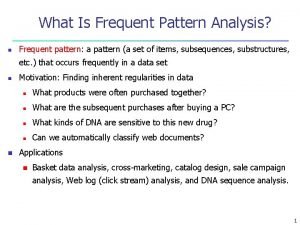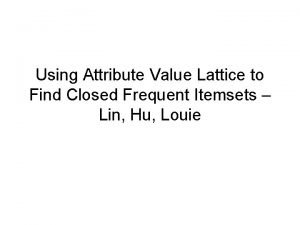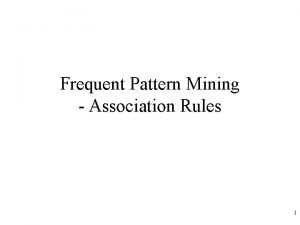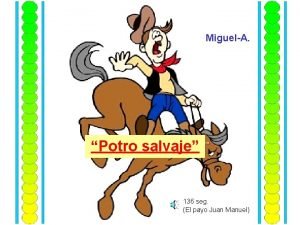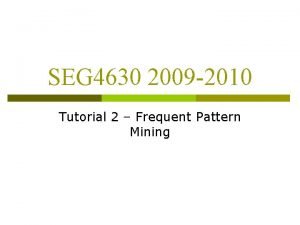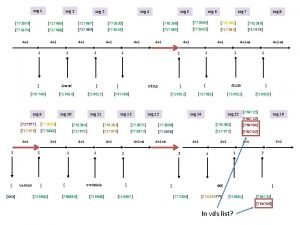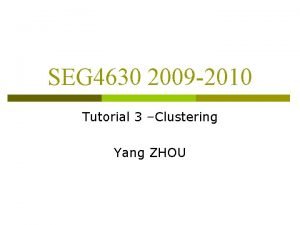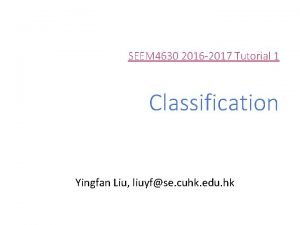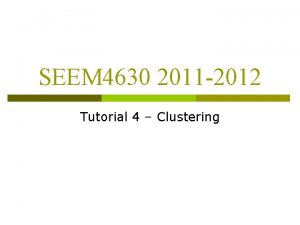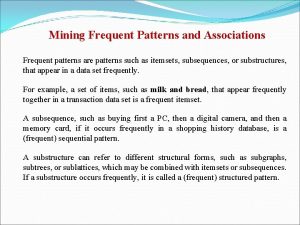SEG 4630 2009 2010 Tutorial 2 Frequent Pattern

















- Slides: 17

SEG 4630 2009 -2010 Tutorial 2 – Frequent Pattern Mining

Frequent Patterns p Frequent pattern: a pattern (a set of items, subsequences, substructures, etc. ) that occurs frequently in a data set n n n itemset: A set of one or more items k itemset: X = {x 1, …, xk} Mining algorithms p p Apriori FP growth Tid Items bought 10 Beer, Nuts, Diaper 20 Beer, Coffee, Diaper 30 Beer, Diaper, Eggs 40 Nuts, Eggs, Milk 50 Nuts, Coffee, Diaper, Eggs, Beer 2

Support & Confidence p Support n n n p (absolute) support, or, support count of X: Frequency or occurrence of an itemset X (relative) support, s, is the fraction of transactions that contains X (i. e. , the probability that a transaction contains X) An itemset X is frequent if X’s support is no less than a minsup threshold Confidence (association rule: X Y ) n sup(X Y)/sup(x) (conditional prob. : Pr(Y|X) = Pr(X^Y)/Pr(X) ) n confidence, c, conditional probability that a transaction having X also contains Y n Find all the rules X Y with minimum support and confidence p p sup(X Y) ≥ minsup sup(X Y)/sup(X) ≥ minconf 3

Apriori Principle p p If an itemset is frequent If an itemset is infrequent too frequent, then all of its subsets must also be (X Y) infrequent, then all of its supersets must be (¬Y ¬X) infrequent 4

Apriori: A Candidate Generation & Test Approach Initially, scan DB once to get frequent 1 itemset p Loop n Generate length (k+1) candidate itemsets from length k frequent itemsets n Test the candidates against DB p n Terminate when no frequent or candidate set can be generated 5

Generate candidate itemsets p Example Frequent 3 itemsets: {1, 2, 3}, {1, 2, 4}, {1, 2, 5}, {1, 3, 4}, {1, 3, 5}, {2, 3, 4}, {2, 3, 5} and {3, 4, 5} Candidate 4 itemset: {1, 2, 3, 4}, {1, 2, 3, 5}, {1, 2, 4, 5}, {1, 3, 4, 5}, {2, 3, 4, 5} n Which need not to be counted? {1, 2, 4, 5} & {1, 3, 4, 5} & {2, 3, 4, 5} n 6

Maximal vs Closed Frequent Itemsets p p An itemset X is a max pattern if X is frequent and there exists no frequent super pattern Y כ X An itemset X is closed if X is frequent and there exists no super pattern Y כ X, with the same support as X Closed Frequent Itemsets are Lossless: the support for any frequent itemset can be deduced from the closed frequent itemsets 7

Maximal vs Closed Frequent Itemsets minsup=2 Closed but not maximal Closed and maximal frequent # Closed = 9 # Maximal = 4 8

Algorithms to find frequent pattern p Apriori: uses a generate and test approach – generates candidate itemsets and tests if they are frequent n n Generation of candidate itemsets is expensive (in both space and time) Support counting is expensive p p p Subset checking (computationally expensive) Multiple Database scans (I/O) FP Growth: allows frequent itemset discovery without candidate generation. Two step: n 1. Build a compact data structure called the FP tree p n 2 passes over the database 2. extracts frequent itemsets directly from the FP tree p Traverse through FP tree 9

Pattern-Growth Approach: Mining Frequent Patterns Without Candidate Generation p The FP Growth Approach n Depth first search (Apriori: Breadth first search) n Avoid explicit candidate generation FP-Growth approach: • • • For each frequent item, construct its conditional pattern-base, and then its conditional FP-tree Repeat the process on each newly created conditional FP-tree Until the resulting FP-tree is empty, or it contains only one path—single path will generate all the combinations of its sub-paths, each of which is a frequent pattern Fp-tree construatioin: • Scan DB once, find frequent 1 -itemset (single item pattern) • Sort frequent items in frequency descending order, f-list • Scan DB again, construct FPtree 10

FP-tree Size p The size of an FP treeis typically smaller than the size of the uncompressed data because many transactions often share a few items in common n n p Best casescenario: All transactions have the same set of items, and the FP treecontains only a single branch of nodes. Worst casescenario: Every transaction has a unique set of items. As none of the transactions have any items in common, the size of the FP treeis effectively the same as the size of the original data. The size of an FP treealso depends on how the items are ordered 11

Example p FP tree with item descending ordering p FP tree with item ascending ordering 12

Find Patterns Having p From P-conditional Database p p p Starting at the frequent item header table in the FP tree Traverse the FP tree by following the link of each frequent item p Accumulate all of transformed prefix paths of item p to form p’s conditional pattern base {} Header Table Item frequency head f 4 c 4 a 3 b 3 m 3 p 3 f: 4 c: 3 c: 1 b: 1 a: 3 b: 1 p: 1 Conditional pattern bases item cond. pattern base c f: 3 a fc: 3 b fca: 1, f: 1, c: 1 m: 2 b: 1 m fca: 2, fcab: 1 p: 2 m: 1 p fcam: 2, cb: 1 13

FP-Growth +p +m +b +a 14

FP-Growth +p (1) +m (2) +a +b (3) (4) +c (5) f: 1, 2, 3, 5 (6) 15

{} {} f: 2 f: 3 c: 1 c: 2 b: 1 c: 3 a: 2 p: 1 a: 3 {} f: 4 c: 3 c: 1 b: 1 a: 3 m: 2 p: 2 b: 1 m: 1 {} f: 2 {} c: 1 f: 3 c: 3 + b a: 1 (3) + m (2) (1) p: 1 b: 1 + p m: 2 {} f: 4 f: 3 + c + a 16 (4) (5) (6)

+p +p +m min_sup = 3 +m +b b: 3 a: 3 fa: 3 ca: 3 fca: 3 +a +c f: 1, 2, 3, 5 p: 3 cp: 3 m: 3 fm: 3 cm: 3 am: 3 fcm: 3 fam: 3 cam: 3 fcam: 3 c: 4 fc: 3 f: 4 17
 Zscore
Zscore Closed pattern and max pattern
Closed pattern and max pattern Closed frequent pattern
Closed frequent pattern Closed frequent pattern
Closed frequent pattern Max pattern and closed pattern
Max pattern and closed pattern Calendario escolar 2009 a 2010 sep
Calendario escolar 2009 a 2010 sep Seg library
Seg library Miguel garzon rate my prof
Miguel garzon rate my prof Seg 3101
Seg 3101 Hvordan bakterier formerer seg
Hvordan bakterier formerer seg Objetivos y metas del pemc ejemplos
Objetivos y metas del pemc ejemplos Seg el
Seg el Sieg seg guanajuato gob mx calificaciones
Sieg seg guanajuato gob mx calificaciones Seam seg
Seam seg Ieee 29148 template
Ieee 29148 template Seg 3101
Seg 3101 Seg 3101
Seg 3101 Seg ter qua
Seg ter qua

